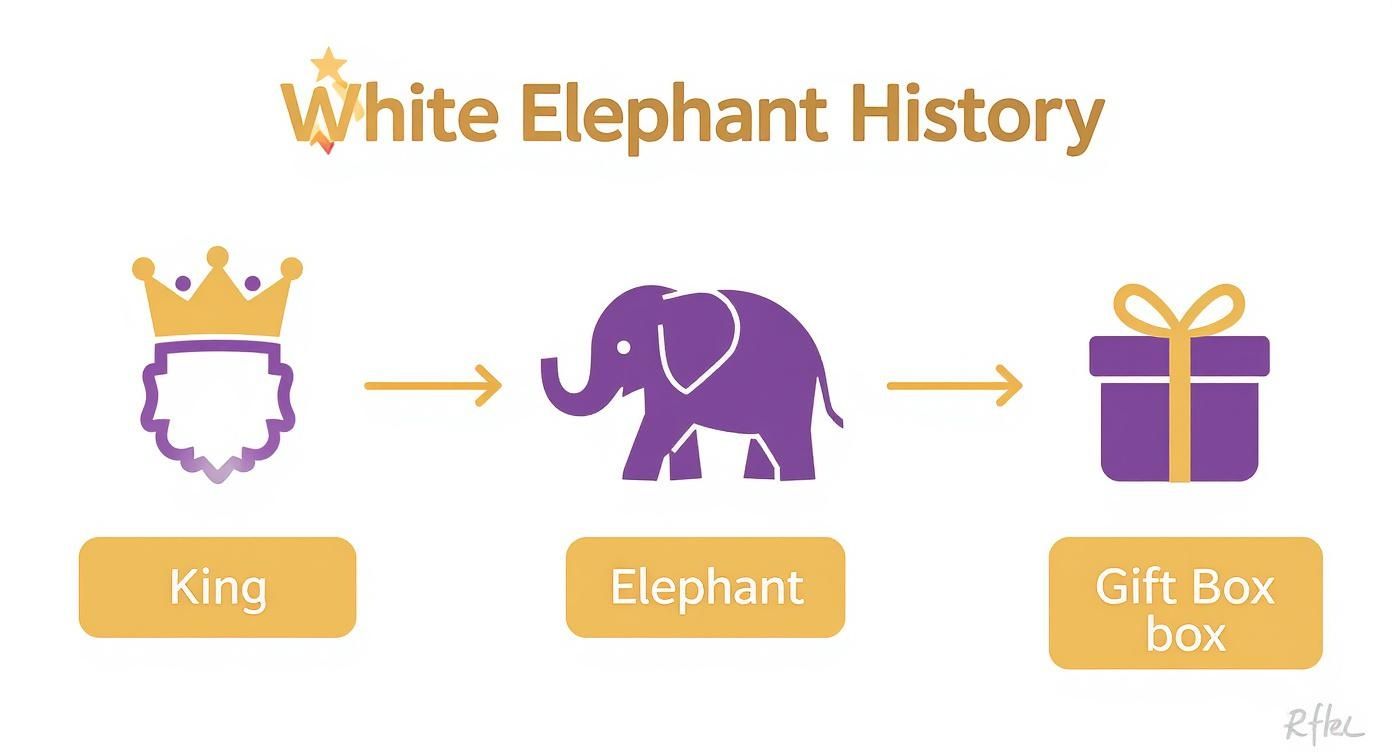A White Elephant gift exchange is one of those awesome, chaotic party games where the real prize is having a good time, not the actual present you go home with. Everyone brings a single wrapped gift, and from there, anything can happen. Players can either pick a mysterious new gift from the pile or, and this is where the fun starts, steal an already opened one from somebody else. It’s all about hilarious swaps and some friendly competition.
So What Is a White Elephant Gift Exchange?

Think of a White Elephant exchange as less of a traditional gift swap and more of an interactive game. The gifts are usually funny, a bit quirky, or just plain weird, which is exactly what makes the whole thing a blast. The goal isn’t to walk away with something amazing; it’s about the laughter and stories that happen along the way.
The core idea is super simple: you bring one gift and leave with a totally different one. The “stealing” part of the game is what really turns it into a dynamic, and sometimes strategic, event. One person’s treasure might be another’s gag gift, and you really never know what you’ll end up with until the very last turn.
The Basic Idea
Here’s how a typical game flows. Everyone puts their wrapped gift into a central pile, and then each player draws a number to figure out the picking order. The person who drew #1 kicks things off by choosing and opening a gift for everyone to see.
From there, every player has a choice: do they unwrap a new, unknown gift, or do they steal a gift that’s already been revealed? This simple decision creates a chain reaction of swaps, sudden betrayals, and temporary alliances. Because it’s so interactive, it’s a great icebreaker for all kinds of gifting holidays and casual get-togethers.
The real magic of a White Elephant exchange isn’t in the gifts themselves but in the stories and laughs that come from the swapping. It’s a game built entirely around shared fun.
To give you a quick snapshot, here’s a breakdown of how the key parts of the game work together.
White Elephant Exchange at a Glance
This table gives you a quick summary of what makes a White Elephant party so much fun.
| Element | Description |
|---|---|
| The Gifts | Typically funny, strange, or impractical items, all kept within a set price limit. |
| The Setup | All wrapped gifts are placed in a central pile where everyone can see them. |
| The Order | Players draw numbers to decide who goes first, second, third, and so on. |
| The Game | Players can either unwrap a new gift from the pile or “steal” an opened one. |
| The Goal | To have as much fun as possible and maybe, just maybe, end up with a cool gift. |
While a White Elephant swap is a classic way to inject some fun into a party, there are plenty of other great options out there. If you’re looking for more ideas, you can check out some of the best party games for adults to make your next celebration one to remember.
The Surprising Royal History of the Game
Ever wonder why we call it a “White Elephant” gift exchange? The name has a pretty wild backstory that’s way more interesting than your average party game, and it all started with actual royalty. The term is a throwback to an old legend from the Kingdom of Siam, which we now know as modern-day Thailand.
As the story goes, the King of Siam had a clever way of dealing with people in his court who got on his bad side. He would “gift” them a rare albino elephant. Getting a real-life white elephant sounds like an incredible honor, right? Well, not exactly.
There was a catch. These animals were considered sacred, so you couldn’t put them to work or get rid of them. The cost of just feeding and caring for one of these majestic creatures was insane, and it was more than enough to financially ruin the unlucky person who received it.
From Royal Burden to Party Game
This passive-aggressive “gift” was really a huge burden disguised as an honor. Over time, the phrase “white elephant” started being used to describe any possession that was expensive to maintain but ultimately useless.
The modern game cleverly flips this entire idea on its head. This 19th-century origin is why we’re all encouraged to bring funny, bizarre, or slightly impractical gifts to the party. While a white elephant was once a genuine burden, today’s game is all about the fun of swapping quirky items. You can learn more about how this tale shaped modern holiday traditions from the story of the Siam kings.
The game transforms a historic burden into a modern source of fun. The “unwanted” gift is no longer a financial drain but the centerpiece of a hilarious party activity.
This concept of turning gift-giving into a fun, interactive event is a huge part of what makes the holidays so special. There are tons of other unique ways people celebrate, and you can explore some fascinating Christmas gift traditions that have evolved over the years. Knowing the history adds a whole new layer of appreciation to the game we all know and love today.
How to Play With the Classic Rules
Alright, you’ve got the backstory down. Now for the main event: actually playing the game. Getting the classic rules right is the key to hosting a white elephant exchange that’s not just fun but actually runs smoothly. It’s a super simple process, and once you see it in action, you’ll get why it’s such a party staple.
First up, every guest needs to arrive with one wrapped gift. All the presents go into a central pile, think of it as the “gift zone.” The next step is figuring out who goes when. The easiest way to do this is to have everyone draw a number from a hat. If you have 10 guests, you’ll need numbers 1 through 10. Simple.

The Game Begins
The person who drew number one is up first. They head to the pile, pick a gift that looks promising, and unwrap it for everyone to see. And that’s it for them, for now. Their turn is over, and it’s time for player two. This is where things get interesting.
Player two now has a choice. They can either:
- Choose an unwrapped gift from the pile and open it.
- Steal the gift that player one just opened.
If player two decides to steal, player one doesn’t just sit out. They get to go again, either by picking a new gift from the pile or by stealing from someone else (just not the gift that was just taken from them). The turn only ends when someone finally opens a new gift from the pile. Then, it’s player three’s turn to make the same choice.
There’s a reason this game is a classic. The whole thing is based on players drawing numbers for their turn and then deciding whether to open a new gift or steal one that’s already been revealed. It’s the stealing that really amps up the fun and chaos, often making the game last an hour or more depending on how many people are playing. You can find more about how the game’s quirky history shaped its modern rules in these insights into white elephant parties.
Common House Rules to Know
To keep the game from going completely off the rails or lasting forever, most hosts add a few extra “house rules.” They’re totally optional, but they can make the game a lot more manageable for everyone.
A gift is considered “frozen” once it has been stolen a certain number of times, usually three. After that third steal, the gift is locked in with its new owner for the rest of the game.
Here are a couple of other popular house rules to consider:
- No Immediate Steal-Backs: You can’t steal the same gift right back from the person who just took it from you. You have to wait for a later turn to try and get it back.
- The Final Swap: Some groups give player number one a final turn at the very end. Since they never got a chance to steal, they get one last opportunity to swap their gift with any other unlocked gift on the floor.
Fun Rule Variations to Try Next
Once you’ve got the classic rules down, you can start mixing things up to keep your game night fresh year after year. The great thing about a white elephant gift exchange is how easy it is to customize. These variations add new layers of strategy, chaos, and fun, so no two parties are ever the same.
A few small tweaks can completely change the vibe of the game. You’ll often hear names like Yankee Swap or Dirty Santa used for the same thing as White Elephant, and for the most part, the rules are identical. The biggest difference is usually just the vibe, with “Dirty Santa” leaning more into the aggressive, cutthroat stealing part of the game.
Get Creative With Your Swap
Ready to try something new? Adding a theme is one of the easiest ways to shake things up and guide your guests’ gift choices. It helps avoid getting a pile of completely random items and adds a fun challenge for shoppers.
Here are a few popular variations you can introduce at your next party:
- Gift Themes: Announce a theme beforehand. Ideas like “As Seen on TV,” “gifts that start with the letter G,” or “something you can wear” can lead to some hilarious and creative presents.
- The Left-Right Game: Instead of drawing numbers, everyone starts with a gift. The host reads a story that uses the words “left” and “right” a lot. Every time a word is said, you pass your gift in that direction. The gift you’re holding at the end is yours to keep.
- Gift Auction: Give everyone a set amount of fake money to start. Unwrap all the gifts and display them, then let people bid on the ones they want most. It adds a whole new level of competitive fun to the event.
The best part about these variations is how flexible they are. You can mix and match rules to create a version that’s perfect for your specific group of friends or family, making your white elephant gift exchange a memorable tradition.
Gift Ideas and Party Etiquette

Alright, now for the part that can feel a little tricky: picking out the perfect gift and navigating the unwritten rules of the game. Being a great white elephant guest is actually pretty simple. It really just comes down to bringing a gift that hits the right note and being a good sport while you play.
The single most important rule is to respect the price limit. Going way over can make other people feel awkward, and spending too little might come across as cheap. You’re aiming for a gift that’s genuinely funny, strangely useful, or just plain weird, not something you just grabbed from your junk drawer five minutes before leaving.
The best white elephant gifts are the ones that get a reaction. Your goal is to bring the item that everyone is fighting to steal by the end of the night.
And finally, remember to be a good sport. The whole point is to have fun, so if your awesome gift gets stolen, just laugh it off! That chaotic charm is what makes the game so memorable.
What to Bring to the Party
Stuck on what to actually buy? The trick is finding something that’s memorable without blowing your budget. You can find tons of great ideas for white elephant gifts under $25 that are pretty much guaranteed to be a hit.
Here are a few ideas to get you started:
- Hilarious Mugs: Think mugs with funny quotes, odd shapes, or heat-activated images that reveal a surprise.
- Quirky Desk Toys: A desktop tetherball set or a tiny zen garden can be a surprisingly popular item.
- Gourmet Gag Food: Things like bacon-flavored candy canes or pickle-flavored popcorn always get a laugh.
- A Weirdly Specific Gadget: An avocado slicer, a banana-shaped phone holder, or an electric s’mores maker are both funny and secretly functional.
If you’re looking for more festive inspiration, you might find something perfect in these Cozy Christmas Gift Ideas. The key is to bring something you’d secretly want to win for yourself.
Your White Elephant Exchange Questions Answered
Still have a few questions? We get it. A white elephant party has a few moving parts, and it’s totally normal to need some clarity before you dive into the gift-swapping chaos. Think of this as your go-to guide for any last-minute questions.
We’ll clear up any lingering confusion about things like price limits, ideal group sizes, and the super important stealing rules. By the end of this, you’ll feel totally ready to host or join your next party with confidence.
What Is a Good Price Limit for a White Elephant Gift Exchange
The sweet spot for a white elephant price limit is usually somewhere between $15 and $30. This range keeps things affordable for everyone, so nobody feels pressured to spend a ton of money.
More importantly, it’s just enough to allow for some genuinely creative, funny, or quirky gifts. The main thing is that everyone agrees on the limit beforehand to keep the game fair and fun.
How Many People Do You Need to Play White Elephant
You can technically play with as few as four or five people, but the game really gets good with a larger group. The ideal size is around 8 to 15 people.
That number makes sure there are enough gifts in the pool to make the stealing part truly exciting and unpredictable. With too few people, the options are limited. With too many (say, over 20), the game can start to drag on a bit too long.
Can You Steal a Gift Right Back
In most versions of the game, the answer is no. Once a gift is stolen from you, you can’t immediately snatch it back in the same turn. You have to either pick a new, unopened present or steal a different one from someone else.
This rule is really just to keep things moving. It prevents the game from getting stuck in an endless back-and-forth loop between two people who are both obsessed with the same gift.
This keeps the action flowing and gives everyone else a fair shot at the swapping chaos.
FAQs
What’s the main goal of a White Elephant gift exchange?
The real goal isn’t to score the best present — it’s to laugh, steal a few gifts, and enjoy the chaos. It’s about the stories and reactions that happen during the game, not what you take home.
Can you bring any kind of gift?
Pretty much, as long as it fits the agreed price limit. The best gifts are weird, funny, or clever. Think of something that’ll get a reaction — not something serious or sentimental.
Is there a typical price range for gifts?
Most groups stick to $15–$30. It keeps the game fun and fair for everyone while still leaving room for creative or quirky ideas.
How long does a White Elephant game usually last?
It depends on how many players there are and how many times people steal gifts. A group of 10–15 people usually takes around an hour to finish.
Can a gift be stolen more than once?
Yes, but most groups limit the number of steals per gift to three. After the third steal, that gift is “frozen,” and the last person to grab it keeps it for good.
What’s the difference between White Elephant, Yankee Swap, and Dirty Santa?
They’re basically the same game with slightly different names. “Dirty Santa” tends to emphasize the stealing part, while “White Elephant” leans more into the humor.
What happens if two people want the same gift?
If someone steals your gift, you can immediately pick a new one from the pile or steal something else — just not the same gift that was taken from you that turn. It keeps the game moving and the laughs coming.
What’s a good group size for playing?
Anywhere from 8 to 15 people is perfect. Smaller groups can still work, but the stealing and swapping are more entertaining when there are more gifts in the mix.
Do the gifts have to be new?
Not necessarily. Funny thrift store finds, gently used items, or homemade gag gifts can be even better than something brand-new — as long as it’s clean and in good shape.
What’s one tip for hosting a great White Elephant party?
Set the rules and price limit ahead of time, keep the vibe light, and pick a fun playlist. The game is all about energy, laughter, and surprises.





